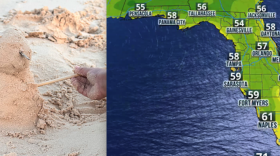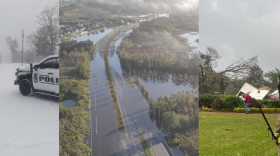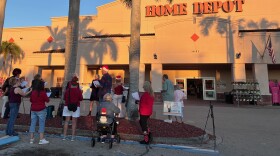Regular, every-day contact tracing for the coronavirus typically entails a health worker calling up to a dozen or so contacts of the person with the known infection. But what does it look like when you're contact tracing the President of the United States, in the hectic, jam-packed last weeks of a reelection campaign?
During the period when he may have already been infected with the coronavirus, President Trump spent time in four states and the District of Columbia, attended at least 10 live events, including private fundraisers and rallies and made contact with an unknown number of people.
A quick, effective contact tracing response could catch any new infections and stop outbreaks from flaring up in those communities. And state and local health workers — as well as the White House medical staff — are working on it.
But it's probably not realistic to ask every one of the President's potential contacts to quarantine and get tested. So how do health workers determine who's at serious risk?
First, they have to assess the time period when the president might have been infectious. With reports that he was showing symptoms as early as Wednesday, the most dangerous time probably started two to three days before that, experts say.
"If you're being really conservative, you might go five days back," says Justin Lessler an epidemiologist at Johns Hopkins Bloomberg School of Public Health. "After the first couple of days, the further you go back, the less likely it is that he was, you know, actually infectious to anybody."
And what really counts as a contact? Does sitting outdoors at a Rose Garden event put you at risk of catching a virus from the President at the podium? The CDC definition of a contact is someone who was within 6 feet of the infected person for at least 15 minutes. Those contacts are the highest risk, Lessler says.
The risk might be lower if both parties were wearing a mask explains Crystal Watson, a senior scholar with the Johns Hopkins Center for Health Security. "While they don't necessarily prevent transmission every time, sometimes [masks] can reduce the amount of virus that is transmitted," she says,and that can mean someone who gets infected might not get as sick.
It's not known if the President wore a mask at all his recent appearances. But he's often appeared without one, and even mocked former Vice President Joe Biden for how regularly he wears them.
But Lessler cautions, close-proximity contacts are not the only at-risk people. There is some risk for anyone who spent extended time in an indoor space with the President (or anyone else who may have been infected).
"Particularly since mask wearing may not have been going on, we would probably consider all of those people in those confined spaces — even if it's a big conference room — as being potential contacts," Lessler says.
That's because the virus can accumulate in the air and potentially spread throughout the room.
Perhaps the biggest challenge in contact tracing in this situation, Watson says, is that it's unknown how Trump himself got infected, so investigators still need to find the original, or "index" case.
"We're seeing more and more evidence that there are additional cases here," she says. "And so we need to understand how big that outbreak is and whether other people should be worried beyond just those who had contact with the president and first lady."
There's some good news here. Many times, the toughest part of tracing contacts is remembering who you were close to.
"This is a very, very different case of contact tracing: It's very hard to forget that you had contact with the President of the United States," says Watson.
Plus almost everyone who spends time in close proximity with the President is on an official list. "He's in some ways the contact tracer's dream because every single person he's contacted, they're going to have a record of it,and there's a very precise schedule," Lessler says.
If all goes well, contact tracers could identify all the people at risk and inform them to quarantine for 14 days and get tested.
But even if they get a negative test result, they may not be in the clear and should remain in quarantine, Lessler says . He explains that there's a high rate of false negatives immediately following exposure to the virus.
"The first couple of days after exposure, the test isn't going to tell you very much. You really need to wait at least a few days after exposure and have any chance of testing positive," he says. "And in the meantime, quarantine."
Copyright 2020 NPR. To see more, visit https://www.npr.org. 9(MDAyMTYyMTU5MDEyOTc4NzE4ODNmYWEwYQ004))










